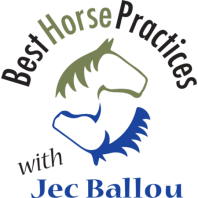26 min listen

Wendy Murdoch, No Stirrup November, Plus Colt Starting
Wendy Murdoch, No Stirrup November, Plus Colt Starting
ratings:
Length:
37 minutes
Released:
Nov 2, 2023
Format:
Podcast episode
Description
We offer these shows for free. If you think it’s worthy of a small contribution, we sure would appreciate it. This is Episode 12 of Season 4 in which Jec interviews Wendy Murdoch, creator of the Murdoch Method and author of several books. Check out her online Whole Rider course here. Before this marvelous interview, I thought I’d share a few bits on my work with two young horses. It’s a departure of sorts, but I hope you enjoy it. We love to hear from listeners. Contact us here. Thanks to our title sponsor, Lucerne Farms, producers of quality forage feeds, extremely handy and healthy bales of alfalfa, timothy, and grass blends. A great addition or substitute for your hay or grass and way better than grain. Because writing and talking helps me to better synthesize and appreciate experiences (and progress and hiccups and trepidations and failures and successes), I wanted to share some words on my time starting two youngish horses, Tuesday and Table. Tuesday is four or five. She came to me as a free-to-a-good-home, dark buckskin, club-footed quarter horse. Table, who was called Lorenzo until this nickname overpowered me, is a five-year old mustang from the Devil’s Garden herd management area in northern California. I acquired him from a gal who seemed afraid to handle him and before that he was with a man who mistreated him, or at least that’s what I was told and, based on Table’s behavior, I’d say is accurate. Both had been handled very little, had never been ridden, and were overweight. That’s where the similarities end. Tuesday had a disrespect for my personal space and was pretty klingy to her herdmates. With work, like creating clear boundaries, testing them, letting her make a mistake and learning from it, those elements of her behavior are improving nicely. She’s a sweet horse and I think it can be tempting to invite her in for some rubs and loving. But for now, it’s more important for her to learn she can be happy with boundaries. She was unsafe in how she encroached, and it would be easy to make her unsafe again. Table tends to be wary of everything, from a phone that suddenly plays music to me wearing a cowboy hat instead of a baseball hat. And even after lots of good work around tying, he still has a tendency to set back. While I am a competent rider and have helped several horses who have come from bad situations, I have never started a horse from the ground up. As luck would have it, my friend, Jessica Munn, came to visit for a month. Jess is a colt starter, with a background in dressage as well as cowboying. It hadn’t been our plan to dedicate so much time to Table and Tuesday, but I’m so grateful that we were both able to commit to this focused work. Her help has been fundamental to our progress and I am deeply indebted to Jess for the knowledge and encouragement she brought to the pen. Oh, and she relearned me on the bowline knot, which I learned as a kid but had a hard time tying it as a horse-tying knot. If you have a horse that might set back, a bowline is a better knot to tie than a quick release knot. Over several weeks, we worked every day to get both of them more comfortable with many aspects of this horse-human thing. Like, for instance, being tied for decent periods of time (20 minutes or more), being hobbled, being led, being tacked up, having feet handled and trimmed, and being away from herdmates. That’s a broad brush and it’s tempting to think this checklist was ticked off in an afternoon. Far from it. Getting these horses to be better citizens was a road full of frost heaves and potholes. We worked every day, for one or two hours with each horse. We built on the previous days’ work and almost always revisited what we’d done in days past. There is a great deal of repetition in good horse work. We do this so the horse knows what to expect in the form of boundaries and performance: when I apply pressure, you move away from it. When I tie you, you get to chill. When the other hors
Released:
Nov 2, 2023
Format:
Podcast episode
Titles in the series (100)
Daniel Dauphin: For this episode, I’m taking the reins, like ya do, from my colleague Jec, to talk with . Dauphin is a Louisiana horseman who lives about halfway between Houston and New Orleans. He has an engaging website that caught my attention for the depth of... by Best Horse Practices Podcast